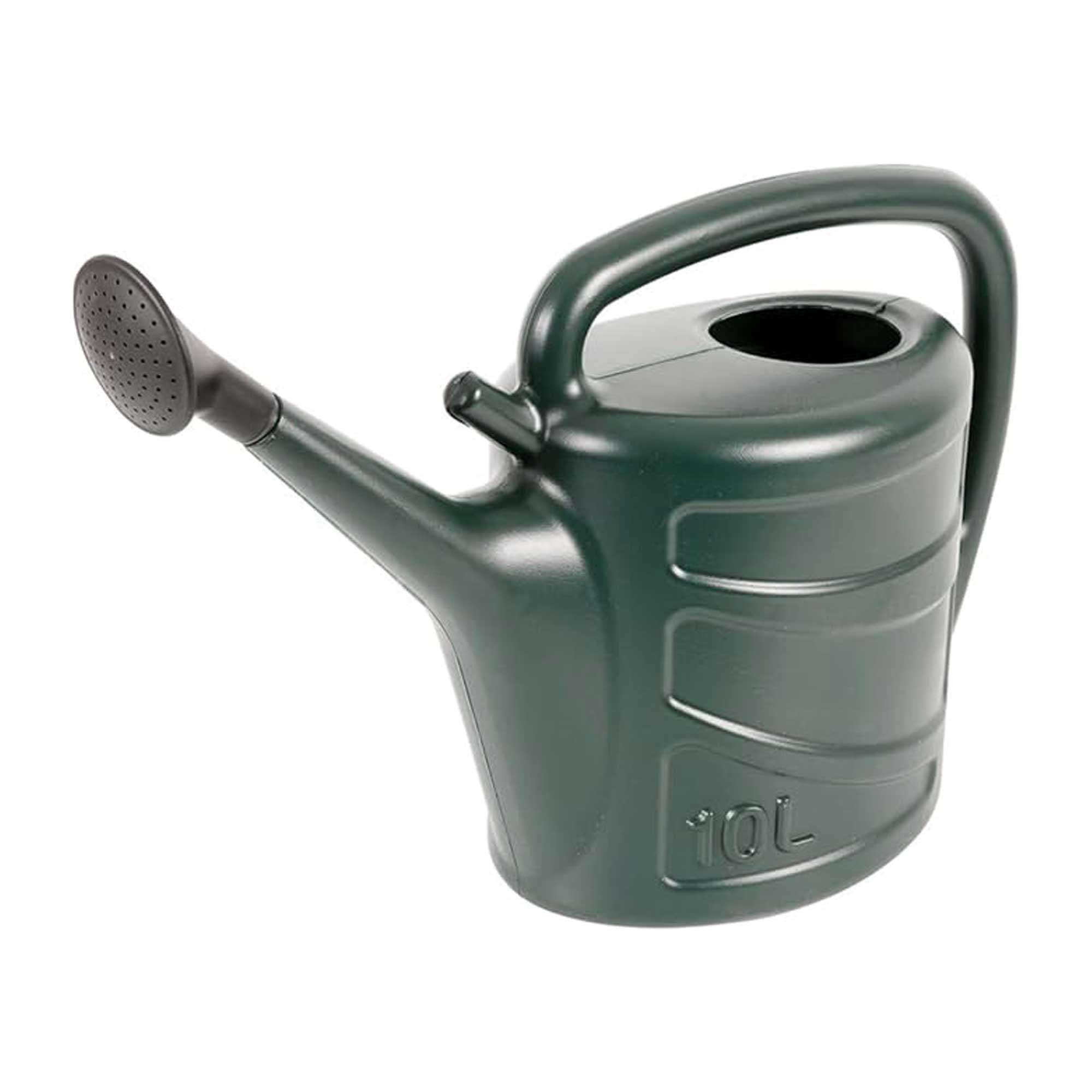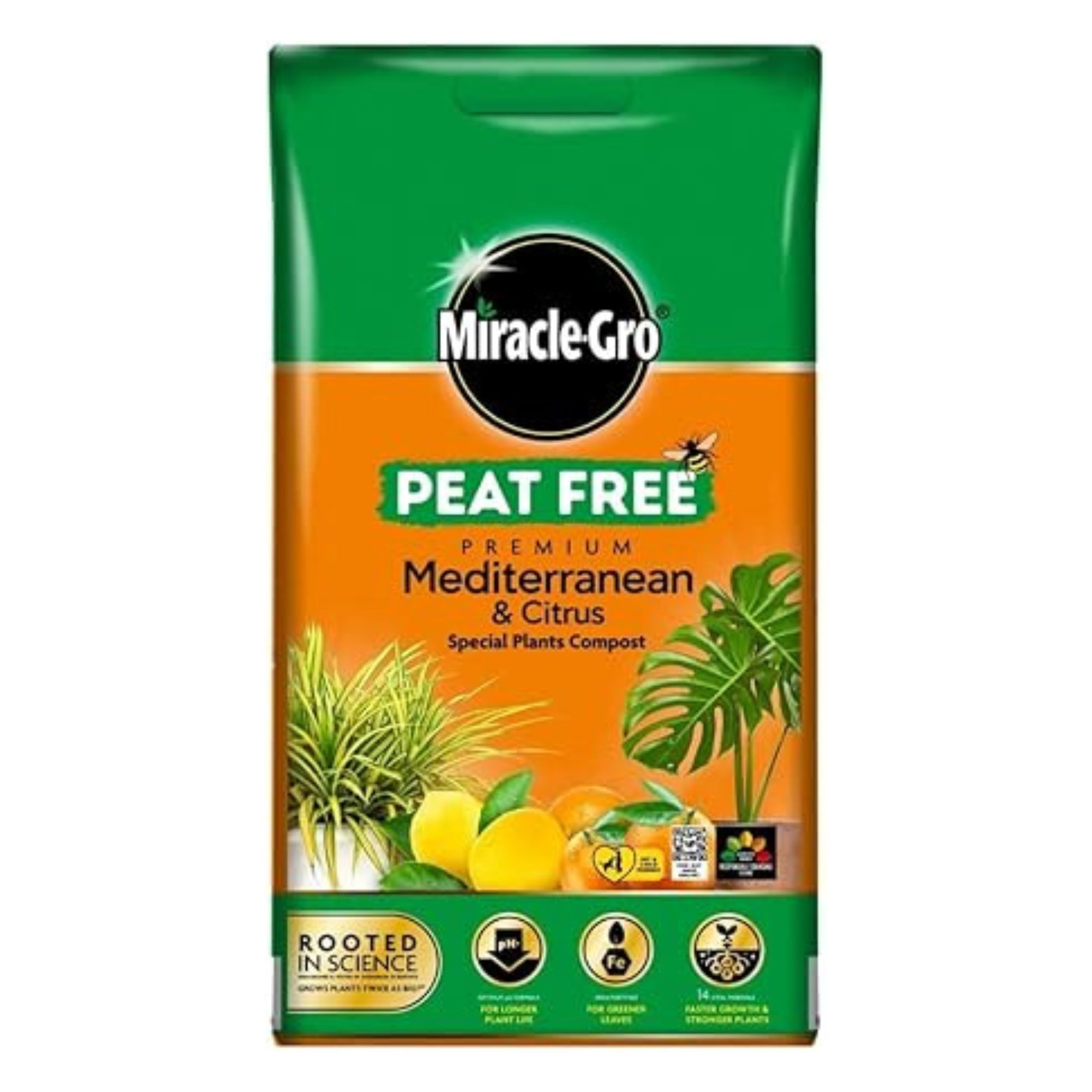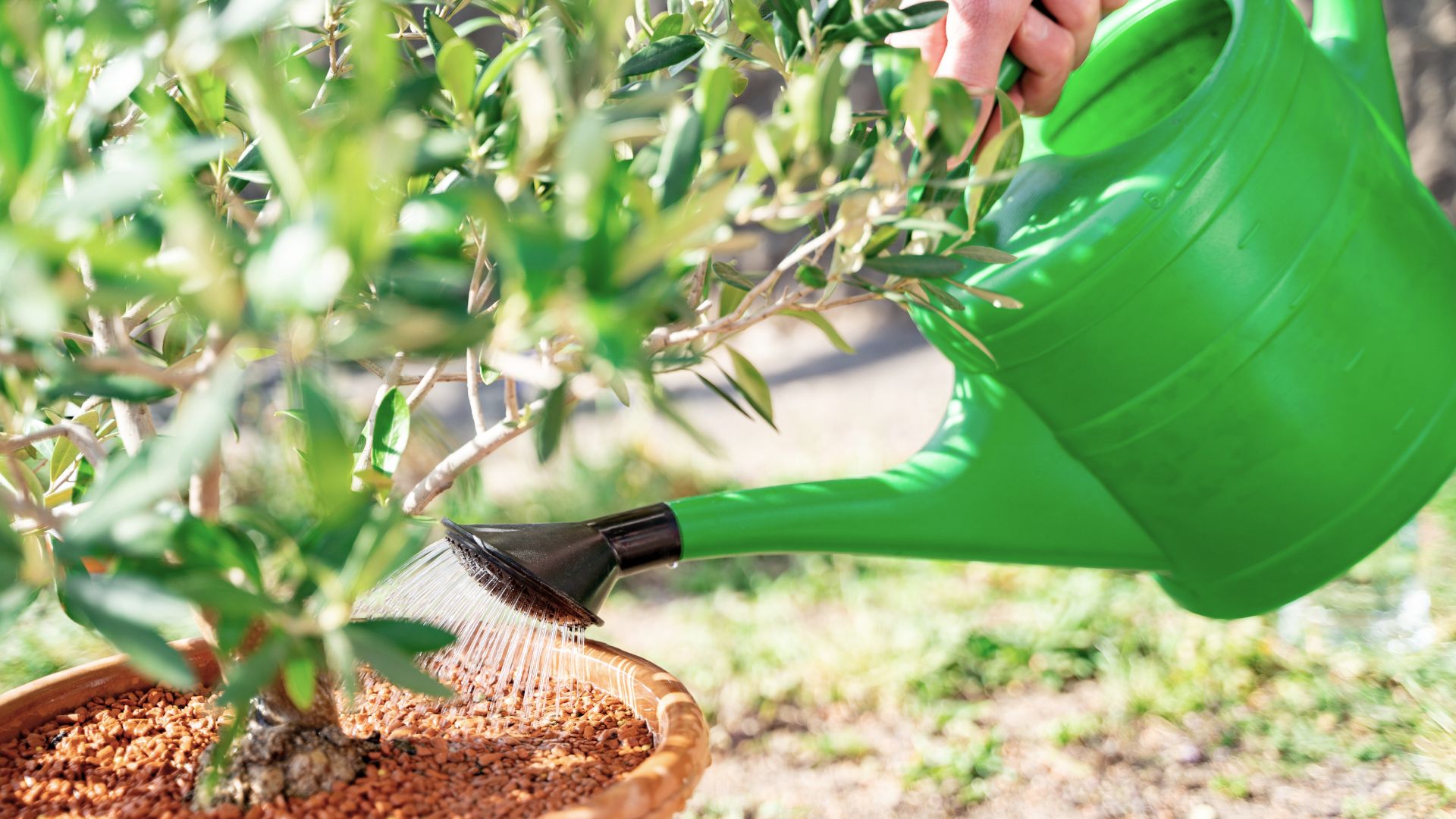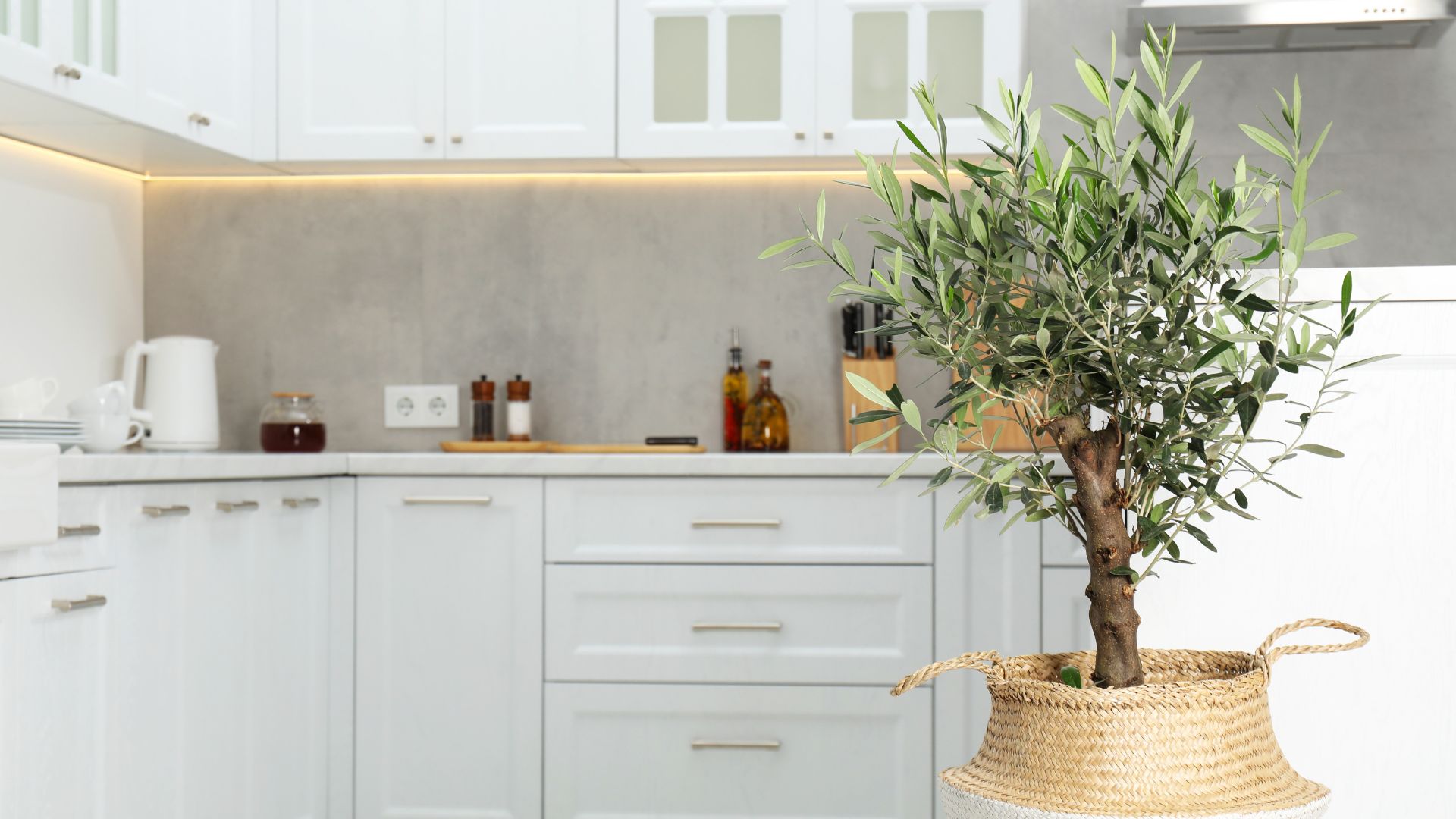How to care for an olive tree: a comprehensive guide to keep your Mediterranean plant happy
Horticulture experts share their advice on keeping an olive tree happy and fruitful all year round


If you want a plant that is going to elevate the look of your space while also providing you with some delicious fruit, then olive trees are an excellent choice. And, to keep the plant happy and the olive supply high, you'll want to follow this expert guide on essential maintenance.
Olive trees are one of the best trees for pots and can be a great addition to your indoor and outdoor plant collection. They're a fantastic way of bringing much-loved Mediterranean garden ideas to life.
Olive trees are surprisingly easy to care for, so it's no real surprise they're becoming an increasingly popular garden trend. However, it's important to know all you can about keeping them happy and healthy, which is why we asked horticulture experts for their no-nonsense care guide.
How to care for an olive tree: an expert guide
Whether you're trying out a new garden theme or simply want to learn how to care for your olive tree properly, we asked the experts for their advice on each step.
Shop plant care essentials

RRP: £11.95 | These popular secateurs feature a carbon steel blade and lightweight, non-slip handles, making precision pruning and deadheading easy.

RRP: £12.99 | This weather-resistant plastic watering can from Accurate has a large capacity and includes a detachable sprinkler rose. It's ideal for larger, more established olive trees in your garden.

RRP: £7.51 | Not only is this soil specifically formualted for mediterranean plants, like olive trees, it's also peat-free making it fantastic for the environment.
Get the watering schedule right

Learning how to water your garden plants properly is an easy way of creating a happy and thriving garden with long-term growth.
"Olive trees that are newly planted need to be watered deeply 2-3 times a week during the spring and summer, ideally with a soaker hose or drip irrigation. It's fine to water established trees 5-7 years old every few weeks, letting the soil dry between waterings," explains Jane Dobbs, Lead Gardener at Allan's Gardeners.
She points out that you'll need to reduce this watering during autumn and winter. "Only supplement with water if there's not enough rain. Don't water potted trees until the soil is dry. You should water deeply, saturating the soil until it drains from the bottom," adds Jane.
Sign up to our free daily email for the latest royal and entertainment news, interesting opinion, expert advice on styling and beauty trends, and no-nonsense guides to the health and wellness questions you want answered.

Gardening is Jane's passion, having built and maintained stunning outdoor spaces for over a decade. Taking care of all the garden projects at Allans' Gardeners is her responsibility as lead gardener. A wide range of horticultural practices come into play in Jane's work, from landscape design to plant and lawn care.
Establish a healthy soil mix
If you've planted your olive tree in the ground, you'll want to make sure you've got the right soil type. On the other hand, if it's being kept in a pot there are specific soil mixes you need to use, like the one linked above.
"Olive trees need a well-draining soil because they hate having wet roots. The ideal mix for them is a sandy or loamy soil with good drainage. If you're planting them in clay soil, amend it with grit, sand or perlite to improve the aeration. The pH range should be neutral to slightly alkaline, around 6.5 to 8.5," recommends Petar Ivanov, gardening expert at Fantastic Gardeners.

Peter has been a gardening and plant expert at Fantastic Gardeners for over 8 years, he is now one of the company's top-performing experts and manages over 6 teams of gardeners. He works on creating stunning landscapes and prioritises sustainability in his gardening methods.
Maintain a feeding routine

Forgetting to feed your plants isn't just a common houseplant mistake; it's also easily done with outdoor species, too. The soil in UK gardens won't always be able to provide more exotic plants with what they need year-round, so it's important to know when to feed them and what with.
Jane says, "You can apply a balanced, slow-release fertiliser in early spring and again in mid-summer. Blend guano, seaweed, and Epsom salts with a slow-release fertiliser high in potassium, phosphate, and magnesium."
Stay on top of pruning
Knowing how to prune your olive tree will help with its growth, fruit production and keeping its overall shape intact.
"You need to make sure to prune an olive tree annually in late winter or early spring to maintain its shape and remove any dead or crossing branches," advises Luke Dejahang, garden expert and CEO of Crown Pavillions.
It's important to remove diseased branches or leaves, too, before the issue can become any worse and lead to your plant's health deteriorating.
Balance the light exposure

Olive trees are native plants from the Mediterranean, so it's no surprise they like their fair share of sun and warmth.
"Sunlight is critical for olive trees. They need full sun, at least 6 hours a day, preferably 8 or more. The best positioning for an olive tree is in the open, unobstructed by buildings or large trees. Somewhere south-facing in the Northern Hemisphere will be ideal," says Petar.
This is not a plant that likes shade, it can tolerate some afternoon shade but it's key to place it in your garden where it'll get the most sun.
"If you're growing it in a pot indoors or on a patio, place the tree near a south-facing window or use grow lights during darker months," Petar adds.
Tend to potting and repotting needs
Although you won't need to do it too often, knowing how to repot your plant is key to ensuring its long-term growth and health. Keeping a plant in a small pot for too long can stunt its growth and cause it to eventually die.
"Terracotta pots with drainage holes are ideal for potting. A gravel or crock can be added to the bottom of the container to improve drainage," advises Jane.
She adds, "Whenever a tree outgrows its pot, move it to a larger container. Ideally, repotting should be done in the spring and do not use plastic pots since they retain moisture."
FAQs
Where to grow an olive tree?
As both a great plant for the garden and one of the best indoor plants, you have some choice about where you want your olive tree to live.
"For outdoor growing, you'll need to be in a region that has mild winters, and the tree will need to be sheltered. If grown indoors, it can be planted in containers. A bright, sunny window is ideal, and the tree should be rotated regularly to ensure even growth," recommends Jane.
Should you live in more northern areas of the UK, you might struggle to keep an olive tree happy, especially through particularly cold and wet winters. Although you can learn to overwinter your olive tree which will give them a better chance of surviving through drops in temperature.
How do I keep my olive tree happy?

Should you be the sort of plant parent who prefers having the easiest plants to keep alive, then you'll be glad to know that keeping an olive plant happy is pretty straightforward.
"Make sure that it gets plenty of sunlight and avoid overwatering because olive trees prefer dry conditions and dislike soggy roots. They also thrive in low humidity, so there is no need to mist them," advises Luke.
"Moreover, good airflow helps prevent pests and fungal issues, and if your tree is in a container, make sure it has proper drainage. Feeding during the growing season and avoiding sudden environmental changes will also help keep your tree healthy and vibrant," he continues.
Why is my potted olive tree dying?
Have you noticed that your plant has seen better days? There are a few things that could be affecting its health, and ways you can fix them.
"If your potted olive tree is struggling or appears to be dying, there are a few common culprits to consider. Overwatering is one of the most, if not the most, frequent problems, especially if the pot lacks drainage," says Luke.
Other possible stresses include poor light, nutrient deficiencies or sudden temperature changes. Luke also recommends checking the roots; if they're brown and mushy, that's an obvious sign your plant has root rot.
"On the other hand, if the soil is bone dry and the leaves are crispy, it may be underwatered. Pests like scale or spider mites can also cause decline, so make sure to check the leaves and stems closely," he adds.
How to tell if an olive tree needs water?
As with any plant watering routine, it can be hard to know when the perfect time to stop watering or water more is. There are, however, tell-tale signs that your plant needs watering that you can keep an eye out for.
"All you need to do to see if an olive tree needs water is to simply check the soil. Stick your finger about 2-3 inches into the soil, and if it's dry, it is time to water your olive tree. The leaves may also look slightly dull or droopy when the tree is thirsty, so keep an eye on it," says Luke.
Should you be particularly worried about caring for your olive tree, it can be a good idea to keep a keen eye on it. Whilst you're completing your daily cleaning habits why not give your plant a check over, that way you'll never miss a watering session.

Emily joined woman&home as a staff writer after finishing her MA in Magazine Journalism from City University in 2023. After writing various health and news content, she now specialises in lifestyle, covering unique cleaning hacks, gardening how-tos, and everything to help your houseplants thrive.